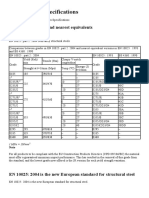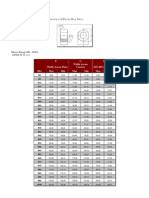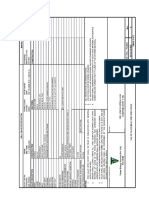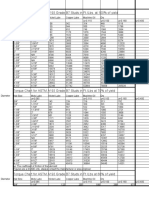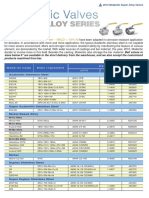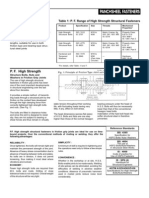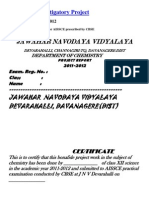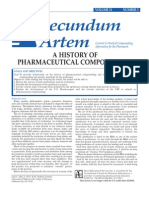0 ratings0% found this document useful (0 votes)
1K viewsStud Bolt Specification
Stud Bolt Specification
Uploaded by
santoshblonkarThe document discusses specifications for various types of bolts and nuts used in structural applications. It provides specifications for metric and imperial high tensile hex bolts, nuts, stud bolts and nuts. It details the material properties, dimensions, property classes/grades and standards that apply for each type. Using high tensile bolts over ordinary bolts provides advantages like reduced number of bolts needed, smaller bolt sizes, lower assembly and maintenance costs and increased joint strength. Charts and tables compare dimensions, grades, tensile strengths and other properties of different bolt and nut types and standards.
Copyright:
© All Rights Reserved
Available Formats
Download as DOCX, PDF, TXT or read online from Scribd
Stud Bolt Specification
Stud Bolt Specification
Uploaded by
santoshblonkar0 ratings0% found this document useful (0 votes)
1K views8 pagesThe document discusses specifications for various types of bolts and nuts used in structural applications. It provides specifications for metric and imperial high tensile hex bolts, nuts, stud bolts and nuts. It details the material properties, dimensions, property classes/grades and standards that apply for each type. Using high tensile bolts over ordinary bolts provides advantages like reduced number of bolts needed, smaller bolt sizes, lower assembly and maintenance costs and increased joint strength. Charts and tables compare dimensions, grades, tensile strengths and other properties of different bolt and nut types and standards.
Original Description:
f
Copyright
© © All Rights Reserved
Available Formats
DOCX, PDF, TXT or read online from Scribd
Share this document
Did you find this document useful?
Is this content inappropriate?
The document discusses specifications for various types of bolts and nuts used in structural applications. It provides specifications for metric and imperial high tensile hex bolts, nuts, stud bolts and nuts. It details the material properties, dimensions, property classes/grades and standards that apply for each type. Using high tensile bolts over ordinary bolts provides advantages like reduced number of bolts needed, smaller bolt sizes, lower assembly and maintenance costs and increased joint strength. Charts and tables compare dimensions, grades, tensile strengths and other properties of different bolt and nut types and standards.
Copyright:
© All Rights Reserved
Available Formats
Download as DOCX, PDF, TXT or read online from Scribd
Download as docx, pdf, or txt
0 ratings0% found this document useful (0 votes)
1K views8 pagesStud Bolt Specification
Stud Bolt Specification
Uploaded by
santoshblonkarThe document discusses specifications for various types of bolts and nuts used in structural applications. It provides specifications for metric and imperial high tensile hex bolts, nuts, stud bolts and nuts. It details the material properties, dimensions, property classes/grades and standards that apply for each type. Using high tensile bolts over ordinary bolts provides advantages like reduced number of bolts needed, smaller bolt sizes, lower assembly and maintenance costs and increased joint strength. Charts and tables compare dimensions, grades, tensile strengths and other properties of different bolt and nut types and standards.
Copyright:
© All Rights Reserved
Available Formats
Download as DOCX, PDF, TXT or read online from Scribd
Download as docx, pdf, or txt
You are on page 1of 8
At a glance
Powered by AI
The document discusses specifications of different types of bolts like metric series bolts, stud bolts, heavy structural friction grip bolts, and compares their dimensions, material properties and strength grades.
The different types of bolts discussed are metric series bolts, stud bolts, heavy structural friction grip bolts.
The advantages of using high tensile bolts discussed are reduced number of bolts, reduced bolt size, less number of holes, reduced size of holes, reduced assembly cost, and reduced maintenance cost.
STUD BOLT SPECIFICATION
High Tensile Hex Bolts/Screws
Metric Series - Dimensions
Note:
1. The bolts and screws will
generally confirm to
IS:1364
2. Threads will generally
confirm to class 6G of
IS:4218
3. Material High grade
carbon / alloy steel
4. Heat Treatment
: Property class 8.8 or
10.9
5. Thread Length : Bolts
shall be half threaded.
Screws
shall be fully threaded.
6. All dimensions are in
millimeters.
Specifications Diameter Range Length Range Property Grade
IS 1364 M 16 - M 64 30 mm - 450 mm IS 1367 Gr. 8.8 / 10.9
High Tensile Hex Head Nuts
Note:
1. The nuts will generally
confirm to IS:1364
2. Threads will generally
confirm to class 6H of
IS:4218
3. Material : High
grade carbon/alloy steel
4. Heat Treatment : As per
property class 8 or 10.
5. In Bolt/Nut assembly,
tightening should be
done by rotation of nut.
6. All dimensions are in
millimeters.
Specifications Diameter Range Grade
IS 1364 M 16 - M 64 IS 1367 Gr. 8 / 10
It is obvious from the following chart that high tensile bolt of property class 8.8 is approximately
four times stronger than an ordinary mild steel bolt of property class 4.6. This extra strength of
high tensile bolts can be used to upgrade an assembled joint from a low tensile one to high
tensile one to gain all the advantage described.
Advantage :
Reduced number of bolts. * Reduced bolt size. *Less numbers of holes.
Reduced size of holes. *Reduced assembly cost. *Reduced maintenance cost.
Strength Grade Tensile Grade Yield Grade
Yield Index
(4.6=100)
4.6 400 Mpa 240 Mpa 100
8.8 800 Mpa 640 Mpa 266
10.9 1000 Mpa 900 Mpa 375
Heavy Structural Friction Grip Bolts-IS 3757
Metric Series - Dimensions
Note:
1. The bolts and screws will generally
confirm to IS:3757-Metric Heavy
Structural Bolts.
2. Threads will confirm to class 6G of
IS:4218
3. Material : High grade carbon / alloy
steel
4. Heat Treatment : As per Property
class 8S or 10S
5. Thread Length
LT for < 100
LT for > 100
6. All dimensions are in millimeters.
Specifications Diameter Range Length Range Property Grade
IS 3757 M 16 - M 36 30 mm - 300 mm IS 1367 Gr. 8.5 / 10.5
Heavy Structural Friction Grip Nuts - IS 6623
Note:
1. The nuts will generally confirm to IS:6623
Metric Heavy Structural nuts.
2. Threads will generally confirm to class 6H of
IS:4218
3. Material : High grade carbon/alloy steel
4. Heat Treatment : As per property class 8 to
10.
5. In Bolt/Nut assembly, tightening should be
done by rotation of nut.
6. All dimensions are in millimeters.
Specifications Diameter Range Grade
IS 6623 M 16 - M 36 IS 1367 Gr. 8 / 10
In expanding use of constructional steel, particularly in bridges and other structures where the
weight of the structure itself is extremely important initiated to use a bolt with higher strength and
heavy hex than those of normal high tensile bolts.
Higher value for your money
Cost of fasteners is disproportionate with their utility. Consequently, the reliability of 95%
cost, of the project resets on 5% cost of the fastners giving them high value responsibility
in structural joints.
The IPC cost (In Place Coast), for a given joint, can be reduced be using lesser bolts or
smaller diameter bolts. This can only be done through smaller fasteners with tensile
strength.
= = = = = = == = = = =
Stud Bolts ASTM A 193
Inch Series, UNC/UN - Dimensions
Note:
1. The stud bolts will generally confirm to
ASTM A 193 Gr:B7
2. Threads will confirm to class 2A of
unified coarse threads as per ANSI B1.1
3. Material : Medium Carbon Chromium
Molybdenum Steel. CR-MO Alloy Steel
(Cr-Mo).
4. Heat Treatment : As per Grade 'B7'
5. All dimensions are in inches.
Specifications Diameter Range Length Range Property Grade
ASTM A 193 1/2" - 3.3/4" 3.1/2" - 40" GR.B7
Hexagon Nuts ASTM A 194
Note:
1. The nuts will generally confirm to ANSI /
ASME B 18.22 Heavy Hex Nuts.
2. Threads will confirm to class 2B of ANSI
B1.1
3. Material and Heat Treatment : As per
Grade '2H'
4. In Bolt/Nut assembly, tightening should
be done by rotation of nut.
5. All dimensions are in inches.
Specifications Diameter Range Grade
ASTM A 194 1/2" - 3.3/4" GR.2H
Stud bolts grade B7 and associated hexagon nuts grade 2H are the most popular grades for
pressure vessels, valves and fittings for High-Temprature / High - Pressure services.
Temperature range : from min -46C to max +538C (for Guidance)
= = = = == = = == = = =
THREAD SIZE COMPARISON
Metric Products
Unified Inch
Products
B.S. Inch Products
Size
Thread Pitch & T.P.I.
Major Dia
Size
T.P.I
Majo
r Dia
Inch
Size
T.P.I
Major
Dia
Inch
T.P.
I
Majo
r Dia
Inch
Coarse Fine
BSW
BS
F
Pitc
h
mm
T.P.I.
Pitc
h
mm
T.P.I
.
mm Inch
UN
C
UN
F
BA
M3 0.50 51 - - 3.00
0.11
8
#5 40 44
0.12
5
1/8 40 - 0.125
#6 32 40
0.13
8
5
BA
4
BA
43.1
38.5
0.12
6
0.14
2
M4
M5
0.70
0.80
36
32
-
-
-
-
4.00
5.00
0.15
7
0.19
7
#8
#10
32
24
36
32
0.16
4
0.19
0
3
BA
3/16
24
32
0.187
34.8
0.16
1
2
BA
1
BA
31.3
28.2
0.18
5
0.20
7
M6 1.0 25 - - 6.00
0.23
6
1/4 20 28
0.25
0
1/4
0BA
20 26 0.250
25.4
0.23
6
M8
M10
1.25
1.50
20
17
1.00
1.25
25
20
8.00
10.0
0
0.31
5
0.39
4
5/16
3/8
18
16
24
24
0.31
3
0.37
5
5/16
3/8
18
16
22
20
0.313
0.375
M12
(M14
)
1.75
2.00
14.5
0
12.5
0
1.25
1.50
20
17
12.0
0
14.0
0
0.47
2
0.55
1
7/16
1/2
14
13
20
20
0.50
0
7/16
1/2
14
12
18
16
0.438
0.500
M16
(M18)
2.00
2.50
12.5
0
10
1.50
1.50
17
17
16.0
0
18.0
0
0.63
0
0.70
9
9/16
5/8
12
11
18
18
0.62
5
9/16
5/8
12
11
16
14
0.500
M20
(M22)
M24
2.50
2.50
3.00
10
10
8.5
1.50
1.50
2.00
17
17
13
20.0
0
22.0
0
24.0
0
0.78
7
0.86
6
0.94
5
3/4
7/8
1
10
9
8
16
14
12
0.75
0
0.87
5
1.00
0
3/4
7/8
1
10
9
8
12
11
10
0.75
0
0.875
1.000
(M27)
3.00
8.5
2.00
13
27.0
0
1.06
3
M30 3.50 7.25 2.00 13
30.0
0
1.18
1
1.1/
8
7 12 1.12
5
1.1/
8
7 9 1.125
(M33)
M36
3.50
4.00
7.25
6.40
2.00
3.00
13
8.5
33.0
0
36.0
0
1.29
9
1.41
7
1.1/
4
7
12
1.25
0
1.1/
4
7
9
1.250
(M39)
M42
4.00
4.50
6.40
5.60
3.00
3.00
8.5
8.5
39.0
0
42.0
0
1.53
5
1.65
3
1.1/
2
6
12
1.50
0
1.1/
2
6
8
1.500
Note : Sizes in brackets are non-preferred standards
= = == = = = = = = =
COMPARISON OF DIFFERENT STRENGTH GRADES
SEA B.S.
IS
I.S.D.
DIN
Ultimate Tensile Strength Hardness
Tonnes/in
2
(kgf/mm
2
)
Newtons/in
2
Min.
(kgf/mm
2
)
Pounds/in
2
Min.
(kgf/mm
2
)
BHN HRd HRc
4.6
400
(40.8)
114
209
67
95
Grade
2
60.000
(42.3)
(121)
(241)
70
100
4.8
420
(408)
124
209
71
95
500
(51.0)
147
209
79
95
Grade
2
74.000
(52.1)
(154)
(241)
80
100
5.8
52.0
(53.0)
152
207
P
35/45
55.2/71.0
152
209
82
95
6.8
600
(61.2)
181
238
89
99
R
45/55
(71.0/86.8)
201
285
(20/33)
S
50/60
(78.9/94.7)
223
310
8.8
800<M16
830>M16
(81.6)
(84.6)
219/285
243/319
20/30
23/34
Grade 1,20,000 (266) 25/34
5 (84.6) (318)
T
55/65
(86.8/102.6)
248
335
(24/36)
U
60/70
(94.7/110.5)
269
331
(28/36)
V
65/75
(120.6/118.4)
293
370
(31/40)
Grade
8
1,50,000
(1.5.7)
(311)
(362)
33/39
10.9
1,040
(106.0)
295
362
31/39
W
70/80
(110.5/126.3)
311
375
(33/41)
X
78/85
(118.4/134.2)
341
410
(37/44)
12.9
1,220
(124.4)
353
412
38/44
Y
80/90
(126.33/142.0)
363
429
39/46
Z
100 Min.
(157.8)
444
(47)
Note: 1.1 kgf=9.81 Newtons kgf/mm
2
= 1421.7 Psi 2) Values in brackets are approximate
conversions.
= = = = = = = =
Grade 8.8 means , Approx. 800 MPa TS and 640 MPa yield strength( you will arrive at the YS by
multiplying the both the numbers times 10. That is 8x8x10=640)
Similarly , 10.9 means approx.1000 MPa TS and 900 MPa yield strength. I have given below the
exact details.
Proper
ty
Class
Tensile
strength,
Mpa
Hardne
ss Material
heat
treatment tempering
4.6 400
B67-
B87
low or medium carbon steel
witth max limits for C 0.55,
P0.048, S0.058 no
4.8 420
B71-
B87
5.8 520
B82-
B95
8.8 830
C23-
C34
medium carbon steel with
max limits for C0.28- 0.55,
P0.048, S0.058
oil
quenched
min 425
deg C
9.8 900
C27-
C36
min 410
deg C
10.9 1040
C33-
C39
min425 de
g C
12.9 1220
C38-
C44
medium carbon steel with
max limits for C0.31- 0.65,
P 0.045 MAX, S 0.045MAX
oil
quenched min 380de
= = = == = = == =
You might also like
- Solution of Transient 2D Heat Conduction Problem Using Freefem++Document4 pagesSolution of Transient 2D Heat Conduction Problem Using Freefem++Chicca PantanoNo ratings yet
- Blind ListDocument3 pagesBlind Listthmaraishri100% (1)
- Equivalents of Carbon Steel QualitiesDocument6 pagesEquivalents of Carbon Steel QualitiesMarcos Fuller AlbanoNo ratings yet
- API 5l x42 Pipe Specification Data SheetDocument1 pageAPI 5l x42 Pipe Specification Data SheetIván López PavezNo ratings yet
- Friction StaysDocument17 pagesFriction StayskmNo ratings yet
- Paddle Blind Thickness Chart Asme Dimensions 11x17Document1 pagePaddle Blind Thickness Chart Asme Dimensions 11x17tekstep7No ratings yet
- SS400 Plate SpecificationDocument1 pageSS400 Plate Specificationthiruprema100% (2)
- Flange Dim EN1092 1 BS4504Document13 pagesFlange Dim EN1092 1 BS4504rcpretoriusNo ratings yet
- Instrumentation Pipe & Weld Fittings: 6000psig, 10000psig and Standard RatingDocument5 pagesInstrumentation Pipe & Weld Fittings: 6000psig, 10000psig and Standard Ratinggohjh80No ratings yet
- EN10025 - Steel Grades SpecificationsDocument6 pagesEN10025 - Steel Grades SpecificationsFYNo ratings yet
- Butterfly ValveDocument6 pagesButterfly ValveRomisamomNo ratings yet
- Materials Comparison DIN / EN / ASTM: Pipes / Tubes Flanges Buttwelding FittingsDocument1 pageMaterials Comparison DIN / EN / ASTM: Pipes / Tubes Flanges Buttwelding Fittingsnaseema1No ratings yet
- Welding CalculatorDocument18 pagesWelding CalculatorKhamdi AfandiNo ratings yet
- 20G Boiler Steel Pipe PDFDocument5 pages20G Boiler Steel Pipe PDFHeza FirdausNo ratings yet
- ANSI B16.9 Elbow PDFDocument3 pagesANSI B16.9 Elbow PDFRamadan RashadNo ratings yet
- Din Flange Din 2627: (Dimensions in MM.)Document12 pagesDin Flange Din 2627: (Dimensions in MM.)Wisüttisäk PeäröönNo ratings yet
- Ss 400Document4 pagesSs 400A Rahim A Bakar100% (2)
- AstmDocument6 pagesAstmMasih BelajarNo ratings yet
- Torque Values B7 Studs PDFDocument1 pageTorque Values B7 Studs PDFipsthethiNo ratings yet
- SUR - Erection BOQ - ST & Geno - Rev ADocument5 pagesSUR - Erection BOQ - ST & Geno - Rev Ashaikhsajid242No ratings yet
- JIS Flange InformationDocument3 pagesJIS Flange Informationmcoswald83No ratings yet
- Some Acceptable Weld Joint As Per IBR RegulationsDocument13 pagesSome Acceptable Weld Joint As Per IBR RegulationsИлия ГеоргиевNo ratings yet
- Dimensions of Heavy Hex Nuts ASME B 18.2.4Document2 pagesDimensions of Heavy Hex Nuts ASME B 18.2.4Ionut Carp100% (1)
- Testing Blind Plate TableDocument5 pagesTesting Blind Plate TableJossel Panopio JoseNo ratings yet
- MATERIAL Comp - Chart China GB Stand. Vis A Vis ASME Stand.Document1 pageMATERIAL Comp - Chart China GB Stand. Vis A Vis ASME Stand.S.KAMBAN67% (3)
- Toyo Valve PN TypeDocument12 pagesToyo Valve PN Typent_long76No ratings yet
- Catalogo GASKET General Measurement TablesDocument20 pagesCatalogo GASKET General Measurement TablescastibraNo ratings yet
- Metal Chemical CompositionDocument1 pageMetal Chemical CompositionprathmeshNo ratings yet
- 12 Valves SpecificationsDocument19 pages12 Valves Specificationsshaliq28100% (1)
- Eng-Lifting Lug 01Document1 pageEng-Lifting Lug 01AbderraoufAffesNo ratings yet
- Torque Chart For ASTM A193 Grade B7 StudsDocument3 pagesTorque Chart For ASTM A193 Grade B7 StudsEmmanuel100% (2)
- Dimensionen Flansche U.fittingeDocument13 pagesDimensionen Flansche U.fittingeChristopher Bodys100% (1)
- Weld Consumable CalculatorDocument7 pagesWeld Consumable Calculatormed chabaneNo ratings yet
- Reference Target Torque ValuesDocument1 pageReference Target Torque ValuesloqNo ratings yet
- Selection of Materials For WeldingDocument1 pageSelection of Materials For WeldingUNNIKRISHNAN NAIRNo ratings yet
- A. For Welding Sa 210 Gra1 To Sa 210 GR A1Document1 pageA. For Welding Sa 210 Gra1 To Sa 210 GR A1911targa100% (1)
- Asme Ansi b16.11 Fittings DimensionDocument23 pagesAsme Ansi b16.11 Fittings DimensionAlvaro Enrique MuñozNo ratings yet
- SuperAlloy Catalog 2013Document5 pagesSuperAlloy Catalog 2013Muhammad SalehNo ratings yet
- Studbolts Size (ANSI B 16-5 & B 16-47)Document5 pagesStudbolts Size (ANSI B 16-5 & B 16-47)ardian roekettino100% (2)
- GBT 8163-1999-1doc-Pr - PDFDocument11 pagesGBT 8163-1999-1doc-Pr - PDFTran The ThuNo ratings yet
- Din 2605 PDFDocument3 pagesDin 2605 PDFAdolf-Norbert KosNo ratings yet
- BS Standard NoDocument35 pagesBS Standard NomvooNo ratings yet
- IBR DetailsDocument10 pagesIBR DetailsArindomNo ratings yet
- Hydro Test Pressure For PipesDocument3 pagesHydro Test Pressure For Pipesmilan rabadiyaNo ratings yet
- BS 10 Table Flange Dimensions PDFDocument5 pagesBS 10 Table Flange Dimensions PDFvishwas salunkhe100% (1)
- Check Valve - Wafer TypeDocument2 pagesCheck Valve - Wafer Typehuudung87No ratings yet
- Gasket General DimensionDocument20 pagesGasket General DimensionAnonymous uhQ7OyNo ratings yet
- Flange Dimensions Upto 2400 ReferDocument2 pagesFlange Dimensions Upto 2400 ReferA.Subin DasNo ratings yet
- AWWA Standard FlangesDocument1 pageAWWA Standard Flangesjose cesarNo ratings yet
- 39NiCrMo3 PDFDocument2 pages39NiCrMo3 PDFAmy GriffinNo ratings yet
- 150 LB Flange DimensionsDocument1 page150 LB Flange Dimensionsdirkgates3022No ratings yet
- Catalog Steel Grating Type 2016-10-01Document12 pagesCatalog Steel Grating Type 2016-10-01Kho Chin NganNo ratings yet
- Concentric Swage NippleDocument3 pagesConcentric Swage NippleLuis Fernando Manjarrez AriasNo ratings yet
- Stainless Steel Pipes - Allowable Pressure RatingDocument7 pagesStainless Steel Pipes - Allowable Pressure RatingBahim BahimanNo ratings yet
- IS Materail Specification For General ApplicationDocument1 pageIS Materail Specification For General Applicationravindranathanne100% (1)
- Buried Pipes and Fittings Painting SpecDocument5 pagesBuried Pipes and Fittings Painting SpecRohan Sharma50% (2)
- IS-3757 HT BoltDocument6 pagesIS-3757 HT BoltRam Balak RoyNo ratings yet
- Bolts ReferencesDocument8 pagesBolts ReferencesvinnuzNo ratings yet
- HSFG BoltsDocument4 pagesHSFG BoltspajipitarNo ratings yet
- RITZ Screw SpecificationDocument12 pagesRITZ Screw Specificationmx100sanookNo ratings yet
- Fastenr GradesDocument5 pagesFastenr GradesVipul ShereNo ratings yet
- 3 Activity DefinitionDocument1 page3 Activity DefinitionsantoshblonkarNo ratings yet
- 1 Develop Project CharterDocument1 page1 Develop Project ChartersantoshblonkarNo ratings yet
- 1.6.2 What Does A Hydrostatic or Pneumatic Pressure Test Do?Document1 page1.6.2 What Does A Hydrostatic or Pneumatic Pressure Test Do?santoshblonkarNo ratings yet
- 1 Overlap Scarf JointDocument1 page1 Overlap Scarf JointsantoshblonkarNo ratings yet
- 1.6,1 Asme Code Requirements: Completed Asmeboiler and PressureDocument1 page1.6,1 Asme Code Requirements: Completed Asmeboiler and PressuresantoshblonkarNo ratings yet
- 3 Weather DataDocument1 page3 Weather DatasantoshblonkarNo ratings yet
- Example 1.5 Problem SolutionDocument1 pageExample 1.5 Problem SolutionsantoshblonkarNo ratings yet
- 1 Chilled Water From VAM at 5Document1 page1 Chilled Water From VAM at 5santoshblonkarNo ratings yet
- 5 Power Required For AgitationDocument1 page5 Power Required For AgitationsantoshblonkarNo ratings yet
- 3 Pattern of CirculationDocument1 page3 Pattern of CirculationsantoshblonkarNo ratings yet
- 2 Type of AgitatorDocument1 page2 Type of AgitatorsantoshblonkarNo ratings yet
- 1 There Are Two Types of MixersDocument1 page1 There Are Two Types of MixerssantoshblonkarNo ratings yet
- Bioenergetics Learning ObjectivesDocument4 pagesBioenergetics Learning ObjectivesMaría Valle RodríguezNo ratings yet
- ASTM B107 - 2000 - Standard Specification For Magnesium-Alloy Extruded Bars, Rods, Profiles, Tubes, and WireDocument19 pagesASTM B107 - 2000 - Standard Specification For Magnesium-Alloy Extruded Bars, Rods, Profiles, Tubes, and Wirewanghongxuan66No ratings yet
- Gibbs Free Energy ProblemsDocument3 pagesGibbs Free Energy ProblemsLeticia CarandangNo ratings yet
- Mass Balance in Forced DegradationDocument5 pagesMass Balance in Forced Degradationnagabhyrava100% (1)
- 1032 1st Exam 1040325 A PDFDocument8 pages1032 1st Exam 1040325 A PDFTrung TranNo ratings yet
- CMOS-MEMS SensorDocument16 pagesCMOS-MEMS SensorFaresNo ratings yet
- Frequently Asked Questions About Results: HT No All India Rank Class State Rank Name Critical Thinking TotalDocument1 pageFrequently Asked Questions About Results: HT No All India Rank Class State Rank Name Critical Thinking TotalPintu ChaurasiyaNo ratings yet
- Comparative Tests On RTV Silicone Rubber Coated Porcelain Suspension Insulators in A Salt-Fog ChamberDocument7 pagesComparative Tests On RTV Silicone Rubber Coated Porcelain Suspension Insulators in A Salt-Fog ChamberDebojyoti MukherjeeNo ratings yet
- Curriculum VitaeDocument3 pagesCurriculum Vitaea_ismangil_physicsNo ratings yet
- Heat Transfer Enhance Ment Helical TubeDocument9 pagesHeat Transfer Enhance Ment Helical TubeKartikAgrawalNo ratings yet
- Jawahar Navodaya Vidyalaya: Chemistry Investigatory ProjectDocument8 pagesJawahar Navodaya Vidyalaya: Chemistry Investigatory ProjectPragya Sharma100% (1)
- Deformation and Strengthening Mechanisms - Science and Engineering of Materials Lectures 8 and 9 With Two Slides On A PageDocument15 pagesDeformation and Strengthening Mechanisms - Science and Engineering of Materials Lectures 8 and 9 With Two Slides On A PageTradingView Alert100% (1)
- Part # 1213474, 1213475: Pao-Based Compressor LubricantsDocument4 pagesPart # 1213474, 1213475: Pao-Based Compressor LubricantsLuis ArzolaNo ratings yet
- Bearing Capacity of Rockspub101172495Document13 pagesBearing Capacity of Rockspub101172495Mehdi Mir100% (1)
- USP Monographs - Clavulanate PotassiumDocument6 pagesUSP Monographs - Clavulanate PotassiumMohamad IsmailNo ratings yet
- Casting ProcessDocument6 pagesCasting ProcessniteshNo ratings yet
- Hetmanoils 2Document1 pageHetmanoils 2André LeiteNo ratings yet
- HydrometryDocument24 pagesHydrometryaguilaquecaeNo ratings yet
- CWPDocument3 pagesCWPDerkung BenowatNo ratings yet
- L31 PDFDocument33 pagesL31 PDFadane aynalemNo ratings yet
- Energy Dispersive X-Ray Spectroscopy (EDX)Document6 pagesEnergy Dispersive X-Ray Spectroscopy (EDX)Ali Raza100% (3)
- Tapered Column DesignDocument79 pagesTapered Column DesignfostbarrNo ratings yet
- Drag ForceDocument9 pagesDrag ForceImran BahaNo ratings yet
- Champion Aft-200Document3 pagesChampion Aft-200api-326817817No ratings yet
- AS and A Level Chemistry: Transition GuideDocument80 pagesAS and A Level Chemistry: Transition GuideTedNo ratings yet
- A History of Pharmaceutical CompoundingDocument6 pagesA History of Pharmaceutical CompoundingMauro Ricambi OriginaliNo ratings yet
- hssc1201t SecquizDocument2 pageshssc1201t SecquizKingProNo ratings yet
- DTTS CD3CD4CD8 ReagentDocument2 pagesDTTS CD3CD4CD8 ReagentReaMetrixNo ratings yet
- ArisDocument11 pagesArisfajrinsubhanputra100% (1)









